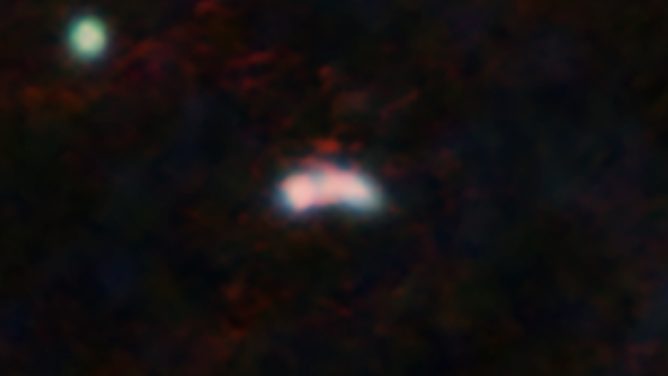2023.01.20
A 1000x Sharper View - Are Magnetically Stabilized Streamers a Fundamental Building Block in High-Mass Star Formation?
The role of the magnetic field in the star-formation process is an extensively debated topic. How strong is the magnetic field? Can it guide material on the way to the star? When and where can gravity overpower the magnetic field? Recently, an international research team led by Patrick Koch at Academia Sinica Institute of Astronomy and Astrophysics (ASIAA), used the Atacama Large Millimeter/submillimeter Array (ALMA) to resolve the magnetic field structure in the W51 e2 and e8 high-mass star-forming regions with an unprecedented resolution of 0.1”. Compared to the earliest magnetic field observations in this region with a resolution of 3”, this is an improvement in resolution by a factor of about 1000 in area. This has only become possible with ALMA’s exquisite sensitivity and resolution which now sharpen our view of the magnetic field by a factor of 1000, making visible details as small as 500 au for the first time.

Figure 1. Visualization of the role of the magnetic field over four essential steps in the star-formation process in the W51 e2 (top) and e8 (bottom) high-mass star-forming regions (from left to right): envelope, global collapse, local collapse, and accreting streamer scale (rightmost panels). Visualized are streamlines, using a line-convolution algorithm based on the actual detected magnetic field morphologies with increasingly higher resolutions from left to right, leading to a 1000x sharper view in the rightmost panels. At the highest resolution of about 500 au (0.1”), the rightmost panels are resolving a network of core-connecting streamers that appear to be channeling material to the center of the star-forming cores. The magnetic field is prevailingly aligned with the streamers, hence stabilizing them against collapse and external pressure. The dashed circles in the rightmost panels indicate the 3” resolution in the leftmost observation, illustrating the tremendous improvement in resolution with ALMA.
Credit:Koch et al.
With a series of successively higher-resolution observations (Figure 1), four distinct scales can be seen. Each scale is capturing the role of the magnetic field in an essential step in the star-formation process and in the accretion of material towards the central stars. These steps trace the material and the magnetic field from the diffuse filamentary envelope (here, the magnetic field is mostly perpendicular to the envelope’s longer axis, supporting accretion onto the filament from the diffuse surrounding), to global collapse (here, gravity initiates an overall collapse but the magnetic field can locally still resist), to local collapse (here, the core is fragmenting into smaller cores and the magnetic field and gravity reveal a self-similar picture to the global collapse), and to accreting dust lanes.
In the last step, an intriguing new phenomenon appears. With the currently highest resolution of about 500 au, the diffuse spherical gas seen on the scale of local collapse is resolved into a network of streamers. These streamers point to the very center where stars form, and very importantly, the measured magnetic field is directed along these streamers. Finding the magnetic field along the streamers is a key result, because it means that the magnetic field tension force can stabilize the streamers against collapse and external pressure. In return, this is providing strong evidence that streamers are magnetically supported. This makes them stable and possibly a fundamental building block in the journey of material accreting onto central stars.
As Patrick Koch concludes, “this is a testimony to ALMA’s superior sensitivity and resolution. No other telescope facility could observe this. We are yet witnessing another role of the magnetic field as it seems to stabilize accretion channels through which material can flow to central core regions where stars form.”
Publication Details
This research was presented in a paper “A Multiscale Picture of the Magnetic Field and Gravity from a Large-scale Filamentary Envelope to Core-accreting Dust Lanes in the High-mass Star-forming Region W51” by Koch et al. appeared in Astrophysical Journal.
This article is based on the press release issued by Academia Sinica Institute of Astronomy and Astrophysics on January 4, 2023.
Additional information
The Atacama Large Millimeter/submillimeter Array (ALMA), an international astronomy facility, is a partnership of the European Organization for Astronomical Research in the Southern Hemisphere (ESO), the U.S. National Science Foundation (NSF) and the National Institutes of Natural Sciences (NINS) of Japan in cooperation with the Republic of Chile. ALMA is funded by ESO on behalf of its Member States, by NSF in cooperation with the National Research Council of Canada (NRC) and the National Science and Technology Council of Taiwan (NSTC), and by NINS in cooperation with the Academia Sinica (AS) in Taiwan and the Korea Astronomy and Space Science Institute (KASI).
ALMA construction and operations are led by ESO on behalf of its Member States; by the National Radio Astronomy Observatory (NRAO), managed by Associated Universities, Inc. (AUI), on behalf of North America; and by the National Astronomical Observatory of Japan (NAOJ) on behalf of East Asia. The Joint ALMA Observatory (JAO) provides the unified leadership and management of the construction, commissioning and operation of ALMA.









